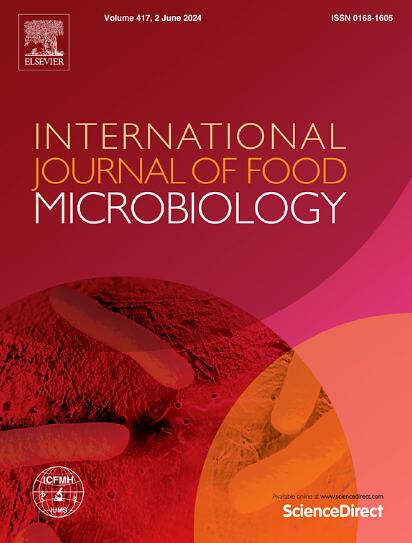Surface application and impact of Yarrowia lipolytica grown in cheese whey as adjunct culture for innovative and fast-ripening Caciotta-like cheeses
IF 5
1区 农林科学
Q1 FOOD SCIENCE & TECHNOLOGY
International journal of food microbiology
Pub Date : 2025-02-15
DOI:10.1016/j.ijfoodmicro.2025.111112
引用次数: 0
Abstract
Cheese whey represents a significant challenge for the dairy industry due to its high chemical and biochemical oxygen demand. However, when utilized as a substrate for microbial growth, it can yield microbial biomass suitable for various food sector applications. In this study, two strains of Yarrowia lipolytica (RO3. and Y3) were cultivated to approximately 7.9 log CFU/mL on cheese whey and subsequently applied as culture adjuncts on the surface of Caciotta-type cheese. The cheeses were produced on an industrial scale and stored at 6 °C for 35 days, during which microbiological (plate counting for total mesophiles, yeasts, lactic acid bacteria, Pseudomonas spp., and Enterobacteriaceae), chemical (water activity, pH, color), proteolytic (SDS-PAGE), lipolytic (Folch method with gas chromatography analyses), and volatile molecule profiles (solid-phase microextraction combined with gas chromatography–mass spectrometry) were analyzed, along with sensory evaluations. Although Y. lipolytica levels declined during storage, its application accelerated the ripening process, enhancing proteolysis and increasing the content of unsaturated fatty acids (25 % for RO3. vs. 19 % in the control) in the cheese paste. Additionally, it promoted the development of ripened cheese aroma compounds (e.g., butanoic, hexanoic, and decanoic acids) on the cheese rind, particularly in cheeses treated with strain Y3. Overall, the findings demonstrate that Y. lipolytica represents a promising approach for valorizing food industry by-products, transforming them into innovative ingredients for sustainable and circular production systems. However, strain selection is crucial, as only Y. lipolytica RO3. produced cheeses with the desired ripening characteristics.
在奶酪乳清中生长的脂溶耶氏菌作为辅助培养物对创新和快速成熟的卡乔塔状奶酪的表面应用和影响
奶酪乳清由于其高化学和生化需氧量,对乳制品行业构成了重大挑战。然而,当用作微生物生长的底物时,它可以产生适合各种食品部门应用的微生物生物量。本研究对两株脂性耶氏菌(RO3)进行了分离。和Y3)在奶酪乳清上培养至约7.9 log CFU/mL,随后作为培养佐剂应用于caciotta型奶酪表面。在工业规模下生产奶酪,并在6°C下保存35天,在此期间,对微生物(嗜中菌、酵母、乳酸菌、假单胞菌和肠杆菌科细菌总数的平板计数)、化学(水活度、pH值、颜色)、蛋白质水解(SDS-PAGE)、脂肪水解(Folch法与气相色谱分析)和挥发性分子谱(固相微萃取结合气相色谱-质谱分析)进行分析。还有感官评估。尽管在贮藏过程中聚脂Y. Y.的含量下降,但它的应用加速了成熟过程,促进了蛋白质水解,增加了不饱和脂肪酸的含量(RO3为25%)。相比之下,对照组为19%)。此外,它促进了成熟奶酪香气化合物(如丁酸、己酸和癸酸)在奶酪皮上的发展,特别是在用菌株Y3处理过的奶酪中。总的来说,研究结果表明,脂解Y.代表了一种很有前途的方法,可以使食品工业副产品增值,将它们转化为可持续和循环生产系统的创新成分。然而,菌株选择是至关重要的,因为只有酵母脂质体RO3。具有理想成熟特征的奶酪。
本文章由计算机程序翻译,如有差异,请以英文原文为准。
求助全文
约1分钟内获得全文
求助全文
来源期刊
CiteScore
10.40
自引率
5.60%
发文量
322
审稿时长
65 days
期刊介绍:
The International Journal of Food Microbiology publishes papers dealing with all aspects of food microbiology. Articles must present information that is novel, has high impact and interest, and is of high scientific quality. They should provide scientific or technological advancement in the specific field of interest of the journal and enhance its strong international reputation. Preliminary or confirmatory results as well as contributions not strictly related to food microbiology will not be considered for publication.

 求助内容:
求助内容: 应助结果提醒方式:
应助结果提醒方式:


